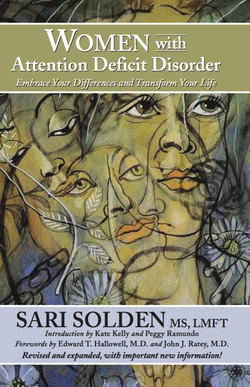Читать книгу Women With Attention Deficit Disorder: Embrace Your Differences and Transform Your Life - Sari Boone's Solden - Страница 7
На сайте Литреса книга снята с продажи.
BEGINNINGS AUTHOR’S PREFACE
ОглавлениеMany women have an extremely difficult time organizing themselves in their daily lives. They frequently feel overwhelmed and may have been struggling with relationships, depression, and underachievement all their lives. Some of these women are hyperactive and fit the stereotyped notion of what most people (even mental health professionals) think that AD/HD is: fast-talking, hyperactive, non-attentive, bouncing-off-the-wall people. Many more women, however, have what is now called the inattentive type of AD/HD. They may have never been hyperactive, but because they don’t fit the more common notion of what AD/HD is, they have never considered AD/HD as a way to explain their difficulties.
Before I first wrote this book in 1995, the standard quoted ratio of AD/HD in boys and girls varied from 6:1 to 10:1. At that time, however, experts were just beginning to discover that this difference was because these studies did not include the quiet, non-hyperactive child. In You Mean I’m Not Lazy, Stupid or Crazy (1995) Kate Kelly and Peggy Ramundo said that if you count girls without hyperactivity, the corresponding ratios approach 1:1. Also back in the early nineties, Dr. Daniel Amen, in his video of Windows into the ADD Mind said that “girls are overlooked, and that this huge under-diagnosis would, if corrected, even out the statistics that regularly report so much larger an occurrence in boys.” Another expert in the field, Dr. Larry Silver, author of The Misunderstood Child (1992), wrote at that time that the ratio of girls to boys with AD/HD was probably much closer to equal because girls who are doing poorly in school are more likely to be withdrawn and quiet, thus appearing disinterested or depressed instead of AD/HD.
In the years since Women with Attention Deficit Disorder was originally published, it has become even more commonly accepted to acknowledge that girls and boys are affected equally when counting the inattentive type of AD/HD. Although there is much overlap between boys and girls in terms of the childhood characteristics of inattentive AD/HD, the struggles they face in adulthood, albeit equally challenging, are often very different because of the gender role expectations that women struggle to meet.
Even though I focus in this book on women who have never been hyperactive, much of what I say about them applies to those who are or were hyperactive, as well. Hyperactivity is not the only or critical element of AD/HD. Other executive functioning deficits challenge women who identify with the symptoms of AD/HD.
